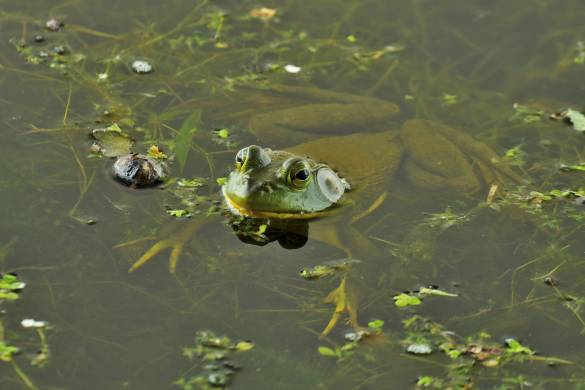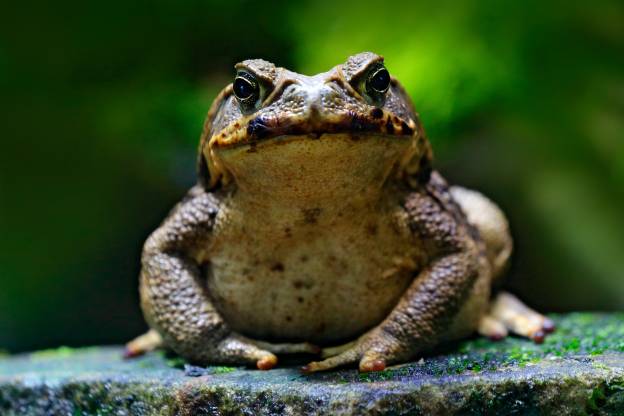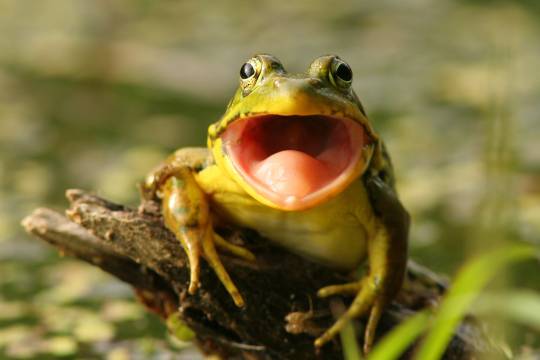Connect with a verified veterinarian in minutes. Licensed vets are available 24/7 to answer your questions. No need to worry about your furry family member.
Have you ever wondered how frogs breathe and if they can breathe underwater? If so, you’re not alone! This is a common question that frog pet parents and others ask on a regular basis.
In researching this article, we found that whether a frog can breathe underwater or not is a little bit complicated. So, we’ll do our best to help you answer this question!
Do Frogs Breathe Underwater?
The short answer to this question is yes! Frogs are amphibians, which means they have the ability to absorb dissolved oxygen through their skin when underwater.
Remember that many frogs, as tadpoles, live in the water. They breathe through gills, much like a fish does. As they become adults, however, frogs lose their gills. At this point, the adult frog develops lungs to help them breathe on land.
However, frogs have another amazing way to breathe, which we’ll look at in the next section.
Frogs Can Breathe Through Their Skin
Adult frogs have very thin skin that’s permeable; the permeable skin has the ability to take in oxygen. A frog can even breathe through his skin underwater, without gills!
Because of the permeability of a frog’s skin, they must remain moist and live in a humid environment. Otherwise, the frog’s body will easily dry out because of this thin skin.

Review symptoms, medications & behavior to keep your pets healthy with a Vet Online in just minutes.
Ask a Vet Live NowFrog’s Lungs are Complex
Frogs, when compared to other amphibians, have complex lungs. Their lungs, similar to ours, are divided into many tiny sacs, called alveoli. These sacs are how gas is exchanged in the lungs.
What’s more, frogs do not have a diaphragm like us. Instead, they use their nostrils and mouth at the same time to bring air into their lungs. You may notice that when a frog inhales, the floor of his mouth lowers. At the same time, the frog’s throat relaxes.
When the nostrils are opened, the air enters into the expanded spaces of the frog’s mouth and throat. The frog then contracts the mouth floor and sends air into the lungs. This breathing process in frogs is called “gular pumping.”
Frogs Have Another Breathing Surface
Did you know that frogs have yet another way to intake oxygen? They have a respiratory surface in the lining of their mouth, which has the ability to exchange gases. When a frog is not active, this may be their main method of breathing. Using the process, the frog only needs to fill his lungs occasionally.
When Do Frogs Use Their Lungs?
Frogs mainly use their lungs when they’re out of the water and moving. This is because they require large amounts of oxygen to get around. Otherwise, a frog at rest may use his skin to breathe.
The frog may use his lungs when chasing after his next meal or if he’s trying to get away from a predatory. These are times when the frog needs more oxygen to move quickly.
How Long Can Frogs Breathe Underwater?
An adult frog may be able to breathe underwater for as long as four to seven hours. However, this is not a proven fact by research.
The reality may be that if the conditions in the frog’s habitat are just right, it’s possible the frog could stay underwater almost indefinitely. The water would need to have plenty of oxygen, for instance.
For a frog in a tank, being in the water all the time is not ideal, even if you have an air pump for his water. What would happen if the electricity all of a sudden cut off? The pump would stop, and if you’re not home, the frog would be stuck in the water. The water would eventually be depleted of oxygen, and the frog could die. This is why it’s important for your pet frog (if he’s not aquatic—living in the water all the time) to have a dry area to get out of the water.
However, at some point, the frog will need to leave the water. He will need to hunt for his meals, as well as find a mate for breeding.
Do Frogs Have the Ability to Life Underwater?
The answer depends on where the frog is in his life cycle. As mentioned earlier, tadpoles will stay in the water until they change into adult frogs. During this life stage, the tadpole breathes in the water with gills. The gills work pretty much the same way as the gills of a fish.
As adults, frogs develop lungs. When on land, the frog can breathe through his skin and his lungs. However, as an adult, the frog cannot live completely in the water unless he’s an aquatic frog, such as an African dwarf frog.
Can Frogs Drown?
The answer to this question is yes. Frogs can drown in water, even though they can breathe through their skin when underwater. The problem is the water may be low in oxygen or even lack oxygen. If that happens, then the frog will drown.
This is why it’s essential to have a place for pet frogs to get out of the water. In fact, there should be more than one way for a frog to leave the water and get on “land” in his tank. It’s possible for a frog to even drown in a water dish, especially a frog that’s very small. If the frog has no way to get out of the water, he will drown.
Why Do Frogs Have Lungs and the Ability to Breathe Through Their Skin?
The answer depends on where the frog is. For example, a frog will use his skin to breathe in the water. However, when he’s on land, this method of breathing is not as efficient. This is why the frog has lungs, too. The lungs are much more efficient when a frog is on land and moving around. The skin just isn’t able to pull in enough oxygen to allow for jumping, hopping, hunting, and more.
On the other hand, when at rest, the frog doesn’t require as much oxygen. So, he may breathe through his skin. This breathing method provides enough oxygen for resting.
So, there you have it! Yes, frogs can breathe underwater! They’re amazing animals who have so many wonderful abilities, even in the different ways they can breathe!
Connect with a verified veterinarian in minutes. Licensed vets are available 24/7 to answer your questions. No need to worry about your furry family member.

Julie
Julie is a graduate of the University of North Carolina, Wilmington, where she studied Animal science. Though contrary to the opinion of her parents she was meant to study pharmacy, but she was in love with animals especially cats. Julie currently works in an animal research institute (NGO) in California and loves spending quality time with her little cat. She has the passion for making research about animals, how they survive, their way of life among others and publishes it. Julie is also happily married with two kids.
Review symptoms, medications & behavior to keep your pets healthy with a Vet Online in just minutes.
Ask a Vet Live Now




